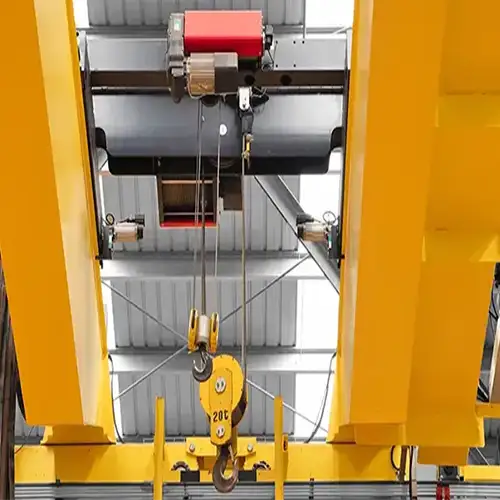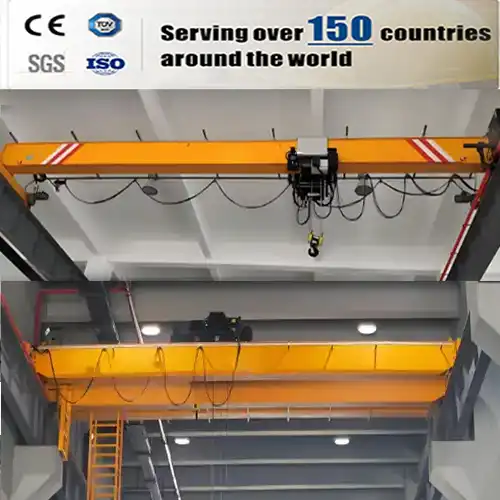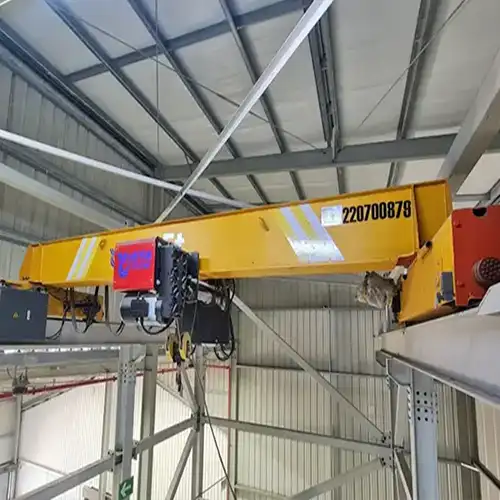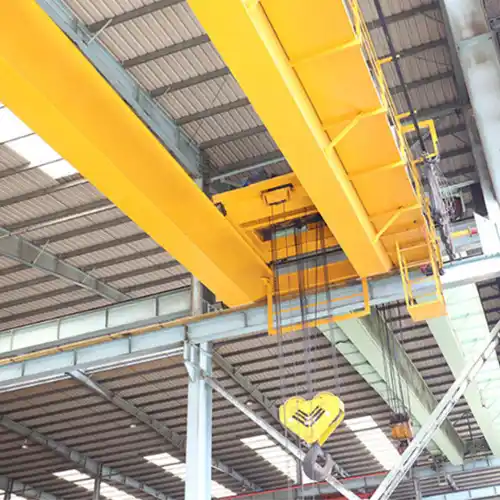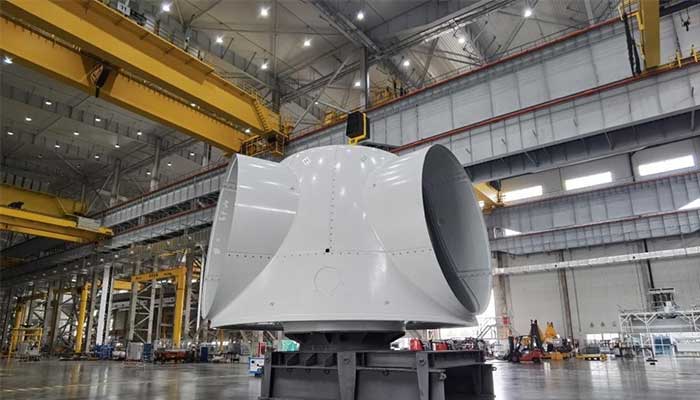
Overhead Crane &Gantry Cranes for Wind Power Turbine Hoisting
Overhead Crane and Gantry Cranes in Wind Power Industries
This article highlights the crucial role that overhead and gantry cranes play in the wind power industry, from the installation to the decommissioning of wind turbines. It discusses the latest advancements in crane technology and emphasizes the importance of crane safety and best practices for crane operations in wind power projects.
Crane for wind power indusrry
The wind power industry is a rapidly growing sector that plays an important role in meeting global energy demands while reducing carbon emissions. Wind power projects involve the installation, maintenance, and repair of wind turbines and other wind power equipment, which can be complex and require specialized equipment such as cranes.
Cranes are essential in the wind power industry as they are used for lifting and positioning heavy components and equipment during installation, maintenance, and repair of wind turbines. Overhead cranes and gantry cranes are commonly used in wind power projects due to their lifting capacity, precision, and maneuverability.
However, the use of cranes in the wind power industry also presents significant safety risks. Crane operators and maintenance staff must be trained and qualified to operate cranes safely and follow strict safety guidelines to prevent accidents and injuries. Wind power projects often take place in challenging environments such as offshore locations or areas with high wind speeds, which can further increase the risks associated with crane operations.
Therefore, it is crucial to prioritize safety when using cranes in the wind power industry. This includes ensuring that cranes are properly maintained and inspected, that operators and maintenance staff are trained and qualified, and that strict safety procedures are followed during crane operations. By prioritizing safety, we can ensure that wind power projects are completed efficiently and effectively while minimizing the risks to workers and the environment.
Types of Cranes Used in Wind Power Industries
Overhead cranes and gantry cranes are two types of cranes that are commonly used in the wind power industry. Here's a more detailed explanation of these two types of cranes:
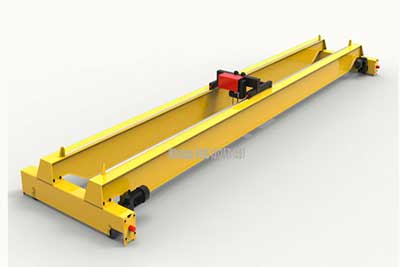
Definition: Overhead cranes are cranes that are suspended from a beam or runway system that is attached to the ceiling or roof of a building. They are typically used for lifting and moving heavy loads within a confined space.
Components: The main components of an overhead crane include a bridge, end trucks, hoist, trolley, runway system, and controls. The bridge is the main horizontal beam that spans the width of the building, while the end trucks are located on either end of the bridge and support the hoist and trolley. The hoist is the lifting mechanism that is attached to the trolley and used to lift and lower loads.
Types: Overhead cranes can be classified based on their lifting capacity and design. Common types include single girder overhead cranes, double girder overhead cranes, and underslung overhead cranes.
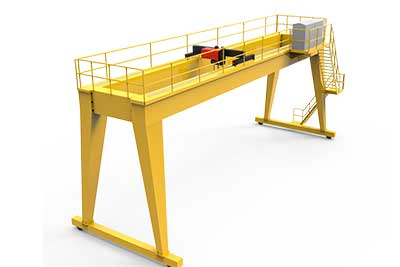
Definition: Gantry cranes are cranes that are supported by legs or columns instead of being suspended from a beam or runway system. They are often used for outdoor applications where overhead clearance is limited.
Components: The main components of a gantry crane include a bridge, end trucks, hoist, trolley, legs or columns, and controls. The bridge is similar to that of an overhead crane, while the end trucks support the hoist and trolley. The legs or columns provide support for the bridge and end trucks.
Types: Gantry cranes can be classified based on their design and mobility. Common types include full gantry cranes, semi-gantry cranes, and mobile gantry cranes.
Comparisons of overhead cranes and gantry cranes
When it comes to wind power industries, both overhead cranes and gantry cranes have their advantages and disadvantages. Overhead cranes are often used for indoor applications where space is limited, while gantry cranes are better suited for outdoor applications where mobility is required. Overhead cranes tend to have higher lifting capacities than gantry cranes, but gantry cranes can be more flexible in terms of their design and configuration.
In general, the choice between overhead cranes and gantry cranes in wind power industries will depend on factors such as the specific lifting requirements, available space, and environmental conditions.
Main Applications of overhead cranes and gantry cranes to the wind turbine industry
Wind turbines are an important source of renewable energy and are used to generate electricity in areas with strong, steady winds, either on land or offshore. However, the heavy components of wind turbines such as blades, nacelles, and towers require specialized overhead cranes for wind power and lifting devices due to their weight and size. The importance of overhead cranes for wind power to the wind turbine industry cannot be overstated.

European style double girder overhead crane with open winch trolley for wind power industry
Overhead Cranes for Main Parts of Wind Turbines Handling
- Rotor Blades: The length and weight of rotor blades require specialized cranes that can handle the load and provide precise control. Blade cranes are designed to lift and position rotor blades during installation and maintenance. Blade cranes typically have a telescoping boom that can extend to the length of the blade and a hydraulic system that provides precise control over the blade position.
- Nacelles: Nacelles are the heaviest component of a wind turbine, and they require specialized cranes that can handle the weight and provide precise control during installation and maintenance. Gantry cranes, tower cranes, and mobile cranes are commonly used for lifting nacelles. Hydraulic gantries are also used in tight spaces where traditional cranes cannot fit.
- Tower Sections: Tower sections are typically lifted into place using tower cranes. These cranes are designed to lift heavy loads to great heights and are capable of handling the weight of the tower sections.
Selecting Appropriate Lifting Equipment
Overall, the lifting equipment used for wind turbines must be carefully selected based on the specific requirements of each task. The weight and size of the component being lifted, as well as the location and accessibility of the site, are all factors that must be considered when selecting the appropriate lifting equipment. overhead cranes for wind power play a crucial role in the wind turbine industry by ensuring safe and efficient lifting and positioning of wind turbine components. Without these specialized lifting devices, the installation and maintenance of wind turbines would not be possible.
Lifting Requirements for Wind Turbines and Other Wind Power Equipment
Weight limits and load distribution for wind turbines and other wind power equipment:
- Wind turbines and other wind power equipment can be extremely heavy and require specialized cranes to lift and position them during installation, maintenance, and repair.
- It is crucial to determine the weight limits and load distribution requirements for each component to ensure that the crane used is capable of lifting the load safely and that the weight is distributed evenly to prevent damage to the equipment.
Wind speed considerations when using cranes in wind power industries:
- Wind speed is a critical factor to consider when using cranes in wind power industries.
- High wind speeds can cause the crane to sway or tip over, which can be dangerous for the operator and other personnel in the area.
- Crane operators must be trained to recognize and respond to changes in wind speed and follow strict safety protocols to prevent accidents.
Importance of precision and accuracy in crane operations:
- Precision and accuracy are essential in crane operations in wind power industries.
- The crane must be positioned precisely to lift and move components without causing damage or injury.
- Crane operators must be trained to operate the crane with precision, using controls to move the load smoothly and avoid sudden movements that could cause the load to swing or tip over.
In addition, it is important to ensure that the crane is properly maintained and inspected regularly to ensure that it is in good working condition. This includes checking the brakes, cables, and other components, as well as lubricating moving parts and replacing worn or damaged parts as needed.
By prioritizing weight limits, load distribution, wind speed considerations, precision, and accuracy in crane operations, we can ensure that wind power projects are completed safely, efficiently, and effectively.
Wind Power Crane Affects Wind Turbine Design to Installation
Site Selection and Assessment:
The first step in a wind turbine project is site selection and assessment. This involves identifying suitable locations for wind turbines and assessing the wind resource potential of the site. During this process, it is important to consider the accessibility of the site for overhead cranes for wind power. Mobile cranes are commonly used in this procedure as they are versatile, easy to operate, and can be used in a variety of terrains.
Design and Engineering:
The next step is designing the wind turbine components such as the rotor blades, tower, and generator, and optimizing their performance. During this phase, overhead cranes for wind power must be designed to handle the specific components of the wind turbine. Tower cranes are ideal for lifting heavy components such as rotor blades, generators, and nacelles.
Manufacturing:
Once the design is finalized, manufacturing begins. It is important to ensure that overhead cranes for wind power are manufactured to the required specifications and standards. Gantry cranes are commonly used in this procedure as they can lift and move heavy loads within a specific area.
Installation:
During installation, overhead cranes for wind power are used to lift and position the wind turbine components. The cranes must be operated by trained personnel who follow strict safety procedures to prevent accidents and damage to equipment. Mobile cranes, tower cranes, and gantry cranes are typically used in this procedure.
Commissioning:
After installation, commissioning begins. overhead cranes for wind power may be used to make final adjustments to the wind turbine components. The cranes must be operated with precision to ensure that the components are properly aligned and functioning correctly.
Operation and Maintenance:
Wind turbines require regular maintenance to ensure optimal performance and extend their lifespan. During operation and maintenance, overhead cranes for wind power may be used to replace or repair components of the wind turbine. Portable gantry cranes are commonly used in this procedure as they are lightweight and can be easily moved to different locations.
Decommissioning:
At the end of its lifespan, the wind turbine must be dismantled and disposed of in an environmentally responsible manner. overhead cranes for wind power are used to dismantle the wind turbine components. Mobile cranes, tower cranes, and gantry cranes are typically used in this procedure.
In conclusion, wind turbine projects require careful planning, design, and execution to ensure safe and efficient operations throughout their lifespan. overhead cranes for wind power play a crucial role in each step of the process, from site selection and assessment to decommissioning. Regular maintenance and monitoring are also essential to ensure optimal performance and extend the lifespan of the wind turbine.

Double girder truss girder goliath gantry crane for wind turbine tower handling
Design and Manufacturing Process for overhead cranes for wind power
overhead cranes for wind power are specialized lifting devices that are essential for the installation and maintenance of wind turbines. The design and manufacturing process for overhead cranes for wind power involves several steps to ensure that the cranes meet the specific requirements of the wind turbine industry.
Design Phase:
The first step in the design phase is to determine the specific requirements of the wind power crane. This includes the weight and size of the components that will be lifted, the height and reach required, and the environmental conditions of the site. Once the requirements are determined, the crane is designed using computer-aided design (CAD) software. The design includes the structural components of the crane, such as the boom, mast, and counterweights, as well as the hydraulic and electrical systems that control the crane.
Use of computer-aided design (CAD) software in crane design:
- Computer-aided design (CAD) software is commonly used in crane design to create detailed 3D models of the crane and its components.
- CAD software allows engineers to visualize and test the crane design before it is manufactured, helping to identify potential issues and improve the design.
- The use of CAD software can also help to reduce manufacturing costs and improve the overall quality of the crane.
Manufacturing Phase:
The manufacturing phase begins with the fabrication of the structural components of the crane. This involves cutting, bending, and welding steel plates to form the boom, mast, and counterweights. The hydraulic and electrical systems are also manufactured during this phase. The hydraulic system includes pumps, valves, and cylinders that control the movement of the crane. The electrical system includes motors, sensors, and controllers that control the hydraulic system.
Quality control measures during crane manufacturing:
- Quality control measures are essential during crane manufacturing to ensure that the crane meets the required specifications and safety standards.
- Quality control measures may include inspections, testing, and documentation of each stage of the manufacturing process.
- Quality control measures may also include training and certification of personnel involved in crane manufacturing to ensure that they are qualified to perform their roles.
Assembly and Testing Phase:
Once all the components are manufactured, they are assembled into the final crane. The assembly includes mounting the boom and mast onto the chassis, installing the hydraulic and electrical systems, and connecting all components. The crane is then tested to ensure that it meets all safety and performance requirements. The testing includes load testing, stability testing, and functional testing of all hydraulic and electrical systems.
Delivery and Installation Phase:
The final phase involves delivering the wind power crane to the installation site and installing it on a suitable foundation. The installation process includes verifying that all components are properly connected and that all safety systems are functioning correctly. Once installed, the crane is ready for use in lifting and positioning wind turbine components.
In conclusion, designing and manufacturing overhead cranes for wind power requires careful consideration of the specific requirements of the wind turbine industry. The cranes must be designed to handle heavy loads at great heights while maintaining precise control. The manufacturing process must ensure that all components are manufactured to strict quality standards and that all hydraulic and electrical systems are tested for safety and performance.
Common materials used in crane construction for wind power industries:- The materials used in crane construction for wind power industries must be strong, durable, and able to withstand harsh environmental conditions.
- Common materials used in crane construction include high-strength steel, aluminum, and composite materials.
- The choice of materials will depend on factors such as the weight of the load being lifted, the environmental conditions in which the crane will be used, and the cost of materials.
In addition to CAD software, quality control measures, and materials selection, it is also important to consider other factors such as safety features, ease of maintenance, and compatibility with other equipment when designing and manufacturing cranes for wind power industries. By using the right materials and manufacturing processes, we can ensure that cranes for wind power industries are safe, reliable, and effective.

L leg single girder gantry crane for wind power industry outdoor use
Maintenance and Repair of overhead cranes for wind power industry
Regular inspections and maintenance procedures for overhead cranes and gantry cranes:
- Regular inspections and maintenance procedures are essential to ensure that overhead cranes and gantry cranes are in good working condition and safe to operate.
- Inspections should be performed daily before the crane is used, as well as on a regular basis (e.g. monthly, quarterly, annually) to identify any issues that may arise.
- Maintenance procedures may include cleaning, lubricating, and adjusting components, as well as replacing worn or damaged parts.
Lubrication, replacement of parts, and troubleshooting of common issues:
- Lubrication is an important maintenance procedure for cranes as it helps to reduce friction and wear on moving parts.
- Replacement of parts may be necessary if components become worn or damaged over time.
- Troubleshooting common issues may involve identifying and addressing problems such as electrical malfunctions, hydraulic leaks, or mechanical failures.
Importance of proper maintenance to ensure crane safety and longevity:
- Proper maintenance is essential to ensure that cranes are safe to operate and have a long service life.
- Neglecting maintenance can lead to equipment failure, which can cause accidents, injuries, and damage to the crane or other equipment.
- Proper maintenance can also help to reduce downtime and repair costs, as well as improve crane efficiency and productivity.
In addition to regular inspections and maintenance procedures, it is important to train crane operators and maintenance staff on proper crane operation and maintenance techniques. This includes following manufacturer guidelines, using appropriate safety equipment, and reporting any issues or concerns promptly. By prioritizing regular inspections and maintenance procedures, we can ensure that cranes in wind power industries are safe, reliable, and effective.
Installation of Wind Turbines and Other Wind Power Equipment
The installation of wind turbines and other wind power equipment involves several stages, including site preparation, foundation construction, assembly of components, and commissioning.Cranes play a crucial role in the assembly of components, including lifting and positioning the turbine tower, nacelle, and rotor blades into place.The use of cranes during installation requires precision and accuracy to ensure that the components are positioned correctly and securely.
Role of cranes in the installation process for wind turbines and other wind power equipmentCranes play a crucial role in the installation process for wind turbines and other wind power equipment. Here's a more detailed explanation of their role:
- Lifting and positioning components: Cranes are used to lift and position heavy components such as turbine blades, nacelles, and towers during installation. This requires precision and accuracy to ensure that the components are positioned correctly and securely.
- Transporting components: Cranes are also used to transport components from the ground to the installation site. This may involve moving components over long distances or across challenging terrain.
- Accessing difficult-to-reach locations: Wind turbines are often located in remote or difficult-to-reach locations, such as offshore or mountainous areas. Cranes can be used to access these locations and position components in place.
- Supporting maintenance and repair: Cranes are also used to support maintenance and repair activities for wind turbines and other wind power equipment. This may involve lifting and positioning replacement components or tools, as well as providing access to difficult-to-reach areas.
Overall, cranes are essential in the installation, maintenance, and repair of wind turbines and other wind power equipment. Their lifting capacity, precision, and maneuverability make them ideal for handling heavy loads in challenging environments. By using cranes effectively, we can ensure that wind power projects are completed safely, efficiently, and effectively.
Use of cranes to lift and position components during construction:- Wind power cranes are commonly used during construction to lift and position heavy components such as steel beams, concrete slabs, and precast panels into place.
- During wind power projects, cranes are used to lift and position components such as turbine blades, nacelles, and towers into place during installation.
- The use of cranes during construction requires specialized operators who are trained in the safe operation of cranes.
In addition to lifting and positioning components, cranes are also used to transport materials and equipment on the construction site. This may involve moving materials over long distances or across challenging terrain. Cranes can also be used to access difficult-to-reach locations on the construction site.
Overall, the use of cranes is essential in the installation of wind turbines and other wind power equipment. By using cranes effectively, we can ensure that wind power projects are completed safely, efficiently, and effectively.

overhead bridge crane for heavy parts and components handling of wind turbines - contact us to get wind turbine hall crane
Safety considerations during crane operations in wind power turbine installations
Safety considerations during crane operations in wind power installations are critical to prevent accidents, injuries, and damage to equipment. Here are some key safety considerations:
- 1. Proper training and certification: Crane operators must be properly trained and certified to operate the crane safely. This includes understanding the crane's capabilities and limitations, as well as following safety protocols and guidelines.
- 2. Risk assessment: A thorough risk assessment should be conducted before crane operations begin to identify potential hazards and develop appropriate safety measures.
- 3. Site preparation: The site should be properly prepared before crane operations begin. This may include leveling the ground, ensuring that the crane is positioned on stable ground, and identifying any potential obstacles or hazards.
- 4. Load capacity: The crane's load capacity should be carefully considered to ensure that it is capable of lifting and positioning components safely. The weight of the load, as well as the wind speed and direction, should be taken into account.
- 5. Weather conditions: Weather conditions can have a significant impact on crane operations. High winds, rain, or snow can make crane operations unsafe, and operators should be trained to recognize and respond to changes in weather conditions.
- 6. Communication: Effective communication is critical during crane operations. Operators should communicate with each other and with other personnel on the site to ensure that everyone is aware of what is happening and can respond appropriately.
- 7. Maintenance and inspection: Regular maintenance and inspection of the crane are essential to ensure that it is in good working condition. This includes checking the brakes, cables, and other components, as well as lubricating moving parts and replacing worn or damaged parts as needed.
By prioritizing safety considerations during crane operations in wind power installations, we can ensure that wind power projects are completed safely, efficiently, and effectively.
Innovations and Advancements in Crane Technology for Wind Power Industries
The wind power industry is constantly evolving, and so is the technology used to install and maintain wind turbines. Innovations and advancements in crane technology are essential for the continued growth and success of the industry. Self-erecting tower cranes, remote-controlled cranes, hybrid cranes, digitalization, and autonomous cranes are just a few examples of the latest advancements in crane technology that are making wind turbine installation and maintenance safer, more efficient, and more sustainable. These advancements allow for precise control of cranes, reduce fuel consumption and emissions, optimize crane operations, and improve safety. As the wind power industry continues to grow, so does the need for more advanced and innovative crane technology.
Remote monitoring systems for crane operations:
- - Remote monitoring systems are becoming increasingly common in crane technology for wind power industries.
- - These systems allow operators to monitor crane operations remotely, providing real-time data on crane performance, maintenance needs, and other important information.
- - Remote monitoring systems can help to improve safety, efficiency, and productivity by allowing operators to respond quickly to any issues that arise.
Automation features to improve crane efficiency and safety:
- - Automation features are also being developed to improve crane efficiency and safety in wind power industries.
- - For example, automated positioning systems can help to ensure that components are positioned correctly and securely, reducing the risk of accidents or damage to equipment.
- - Other automation features may include collision avoidance systems, automatic load sensing, and self-diagnostic systems.
Future trends in crane technology for wind power industries:
- - The future of crane technology for wind power industries is likely to involve continued innovation and development of new features and capabilities.
- - Some potential future trends may include the development of more advanced automation features, such as artificial intelligence and machine learning.
- - Other trends may include the use of alternative energy sources to power cranes, such as solar or wind power, as well as the development of new materials and components that are lighter, stronger, and more durable.
Overall, the continued advancement of crane technology is essential to support the growth and development of wind power industries. By incorporating remote monitoring systems, automation features, and other innovations, we can improve safety, efficiency, and productivity in crane operations for wind power installations.
In conclusion, overhead cranes and gantry cranes play a critical role in the wind power industry. These specialized lifting devices are essential for the installation, maintenance, and decommissioning of wind turbines. They are designed to handle heavy loads at great heights while maintaining precise control, making them an indispensable tool for wind power projects.
Crane safety is of utmost importance in the wind power industry. Best practices for crane operations include proper training of crane operators, regular maintenance and inspections of cranes, and adherence to safety protocols and regulations. It is essential to ensure that all crane operations are conducted safely and efficiently to prevent accidents and injuries.
As the wind power industry continues to grow, so does the demand for advanced crane technology and safety practices. By investing in the latest crane technology and adhering to best practices for crane operations, wind power projects can be completed safely and efficiently, contributing to a more sustainable future for generations to come.
